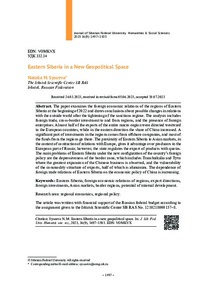Восточная Сибирь в новом геополитическом пространстве
Автор:
Сысоева, Н. М.
Sysoeva, Natalia M.
Дата:
2023-09Журнал:
Журнал Сибирского федерального университета. Гуманитарные науки. Journal of Siberian Federal University. Humanities & Social Sciences; 2023 16 (9)Аннотация:
В статье рассматриваются внешнеэкономические связи регионов
Восточной Сибири на начало 2022 г. и делаются выводы о возможных изменениях
во взаимоотношениях с внешним миром после ужесточения санкционного режима.
Анализ включает внешнюю торговлю, трансграничные инвестиции в регионы
и из регионов, а также присутствие иностранных предприятий. Почти половина
экспорта всего макрорегиона направлялась на запад в страны Европы, при движении
на восток возрастала доля Китая. Значительная часть инвестиций в регионы приходит
из офшоров, туда же уходит большая часть средств из регионов. Близость Восточной
Сибири к азиатским рынкам в условиях сокращения взаимоотношений с Европой
дает ей преимущества перед производителями европейской части России, однако
государство регулирует поставки продукции квотированием. Основные проблемы
Восточной Сибири при новой конфигурации внешней политики страны заключаются
в депрессивности приграничной полосы, включающей Забайкалье и Тыву, где
наблюдается наибольшая экспансия китайского бизнеса, уязвимости товарной
структуры экспорта, половину из которого составляет алюминий. Отмечается
возрастание зависимости внешнеторговых отношений Восточной Сибири
от экономической политики Китая The paper examines the foreign economic relations of the regions of Eastern Siberia at the beginning of 2022 and draws conclusions about possible changes in relations with the outside world after the tightening of the sanctions regime. The analysis includes foreign trade, cross-border investment to and from regions, and the presence of foreign enterprises. Almost half of the exports of the entire macro-region were directed westward to the European countries, while in the eastern direction the share of China increased. A significant part of investments in the regions comes from offshore companies, and most of the funds from the regions go there. The proximity of Eastern Siberia to Asian markets, in the context of contraction of relations with Europe, gives it advantage over producers in the European part of Russia; however, the state regulates the export of products with quotas. The main problems of Eastern Siberia under the new configuration of the country’s foreign policy are the depressiveness of the border zone, which includes Transbaikalia and Tyva where the greatest expansion of the Chinese business is observed, and the vulnerability of the commodity structure of exports, half of which is aluminum. The dependence of foreign trade relations of Eastern Siberia on the economic policy of China is increasing

